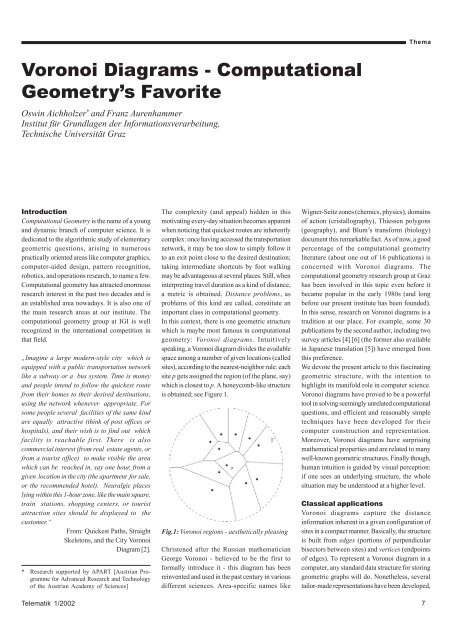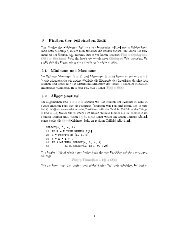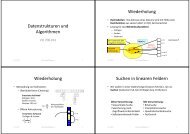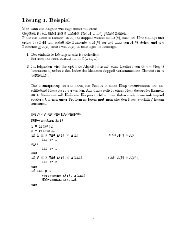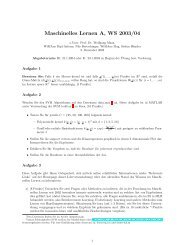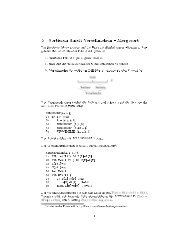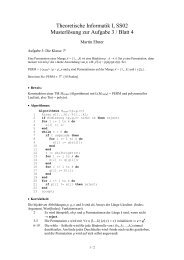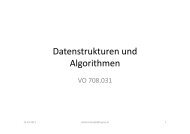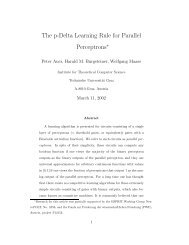Telematik 2/02 - Institut für Grundlagen der Informationsverarbeitung ...
Telematik 2/02 - Institut für Grundlagen der Informationsverarbeitung ...
Telematik 2/02 - Institut für Grundlagen der Informationsverarbeitung ...
You also want an ePaper? Increase the reach of your titles
YUMPU automatically turns print PDFs into web optimized ePapers that Google loves.
Voronoi Diagrams - Computational<br />
Geometry’s Favorite<br />
Oswin Aichholzer * and Franz Aurenhammer<br />
<strong>Institut</strong> <strong>für</strong> <strong>Grundlagen</strong> <strong>der</strong> <strong>Informationsverarbeitung</strong>,<br />
Technische Universität Graz<br />
Introduction<br />
Computational Geometry is the name of a young<br />
and dynamic branch of computer science. It is<br />
dedicated to the algorithmic study of elementary<br />
geometric questions, arising in numerous<br />
practically oriented areas like computer graphics,<br />
computer-aided design, pattern recognition,<br />
robotics, and operations research, to name a few.<br />
Computational geometry has attracted enormous<br />
research interest in the past two decades and is<br />
an established area nowadays. It is also one of<br />
the main research areas at our institute. The<br />
computational geometry group at IGI is well<br />
recognized in the international competition in<br />
that field.<br />
„Imagine a large mo<strong>der</strong>n-style city which is<br />
equipped with a public transportation network<br />
like a subway or a bus system. Time is money<br />
and people intend to follow the quickest route<br />
from their homes to their desired destinations,<br />
using the network whenever appropriate. For<br />
some people several facilities of the same kind<br />
are equally attractive (think of post offices or<br />
hospitals), and their wish is to find out which<br />
facility is reachable first. There is also<br />
commercial interest (from real estate agents, or<br />
from a tourist office) to make visible the area<br />
which can be reached in, say one hour, from a<br />
given location in the city (the apartment for sale,<br />
or the recommended hotel). Neuralgic places<br />
lying within this 1-hour zone, like the main square,<br />
train stations, shopping centers, or tourist<br />
attraction sites should be displayed to the<br />
customer.“<br />
From: Quickest Paths, Straight<br />
Skeletons, and the City Voronoi<br />
Diagram [2].<br />
* Research supported by APART [Austrian Programme<br />
for Advanced Research and Technology<br />
of the Austrian Academy of Sciences]<br />
<strong>Telematik</strong> 1/20<strong>02</strong><br />
The complexity (and appeal) hidden in this<br />
motivating every-day situation becomes apparent<br />
when noticing that quickest routes are inherently<br />
complex: once having accessed the transportation<br />
network, it may be too slow to simply follow it<br />
to an exit point close to the desired destination;<br />
taking intermediate shortcuts by foot walking<br />
may be advantageous at several places. Still, when<br />
interpreting travel duration as a kind of distance,<br />
a metric is obtained. Distance problems, as<br />
problems of this kind are called, constitute an<br />
important class in computational geometry.<br />
In this context, there is one geometric structure<br />
which is maybe most famous in computational<br />
geometry: Voronoi diagrams. Intuitively<br />
speaking, a Voronoi diagram divides the available<br />
space among a number of given locations (called<br />
sites), according to the nearest-neighbor rule: each<br />
site p gets assigned the region (of the plane, say)<br />
which is closest to p. A honeycomb-like structure<br />
is obtained; see Figure 1.<br />
Fig.1: Voronoi regions - aesthetically pleasing<br />
Christened after the Russian mathematician<br />
George Voronoi - believed to be the first to<br />
formally introduce it - this diagram has been<br />
reinvented and used in the past century in various<br />
different sciences. Area-specific names like<br />
Thema<br />
Wigner-Seitz zones (chemics, physics), domains<br />
of action (cristallography), Thiessen polygons<br />
(geography), and Blum’s transform (biology)<br />
document this remarkable fact. As of now, a good<br />
percentage of the computational geometry<br />
literature (about one out of 16 publications) is<br />
concerned with Voronoi diagrams. The<br />
computational geometry research group at Graz<br />
has been involved in this topic even before it<br />
became popular in the early 1980s (and long<br />
before our present institute has been founded).<br />
In this sense, research on Voronoi diagrams is a<br />
tradition at our place. For example, some 30<br />
publications by the second author, including two<br />
survey articles [4] [6] (the former also available<br />
in Japanese translation [5]) have emerged from<br />
this preference.<br />
We devote the present article to this fascinating<br />
geometric structure, with the intention to<br />
highlight its manifold role in computer science.<br />
Voronoi diagrams have proved to be a powerful<br />
tool in solving seemingly unrelated computational<br />
questions, and efficient and reasonably simple<br />
techniques have been developed for their<br />
computer construction and representation.<br />
Moreover, Voronoi diagrams have surprising<br />
mathematical properties and are related to many<br />
well-known geometric structures. Finally though,<br />
human intuition is guided by visual perception:<br />
if one sees an un<strong>der</strong>lying structure, the whole<br />
situation may be un<strong>der</strong>stood at a higher level.<br />
Classical applications<br />
Voronoi diagrams capture the distance<br />
information inherent in a given configuration of<br />
sites in a compact manner. Basically, the structure<br />
is built from edges (portions of perpendicular<br />
bisectors between sites) and vertices (endpoints<br />
of edges). To represent a Voronoi diagram in a<br />
computer, any standard data structure for storing<br />
geometric graphs will do. Nonetheless, several<br />
tailor-made representations have been developed,<br />
7


